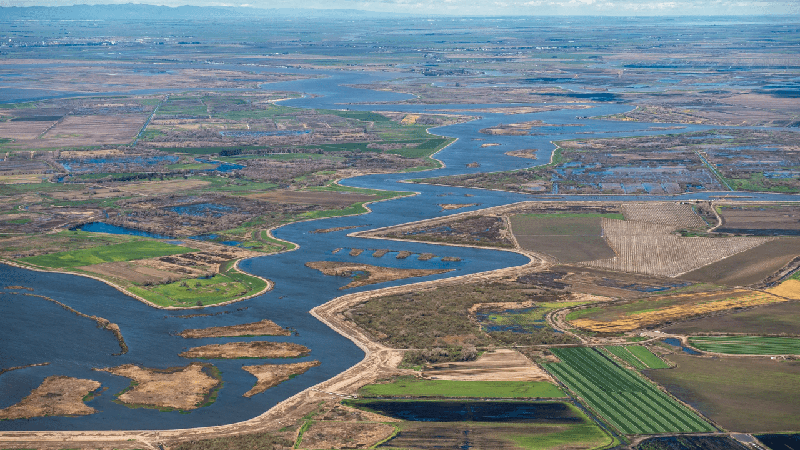

An aerial view of the Middle River in the Sacramento-San Joaquin River Delta. Photo by Ken James, California Department of Water Resources
By RACHEL BECKER
California’s water agency today released a long-awaited environmental report outlining the details and impacts of a controversial proposal to replumb the Sacramento-San Joaquin Delta and pump more water south.
In the report, state officials said the tunnel project could harm endangered and threatened species, including the Delta smelt, winter-run chinook salmon and steelhead trout. To offset the “potentially significant impacts” on the rare fish, the Department of Water Resources says thousands of acres of other wetlands would have to be restored — which critics say is a slow and inefficient way to provide new habitat.
The draft environmental impact report is a major step in planning a tunnel that would fundamentally reshape California’s massive water management system.
The report outlines the proposed path of a 45-mile tunnel that would pipe water from the Sacramento River, bypassing the Delta, and funnel it into Bethany Reservoir, the “first stop” on a state aqueduct that funnels water south.
The goal of the project, which has been planned in various forms since the 1960s, is to shore up water supplies against environmental catastrophes such as earthquakes and the weather whiplash and sea level rise of climate change, according to California Natural Resources Secretary Wade Crowfoot.
Water agencies that can eventually sign on to receive the tunnel project’s water stretch from the Bay Area and Central Coast to the Central Valley and Southern California.
“It is a conundrum to be able to manage the Delta in a way that protects the environment, respects the communities that live there, and provides for the water supplies of a large portion of the state,” Crowfoot said.
The state’s companion explainer for the report, also released today, says changes in flow at and downstream of the tunnel’s intakes “have the potential to decrease migration rates, alter migration routing, reduce availability of rearing habitat, and increase exposure to predation for winter-run Chinook salmon, Central Valley spring-run Chinook salmon, and Central Valley steelhead.”
Carrie Buckman, environmental program manager for the state’s Delta Conveyance Office, said the department’s analysis found that 4% fewer juvenile winter-run chinook would survive during their peak times in the Delta in below-normal water years.
The summary also notes “potentially significant impacts to delta smelt and longfin smelt” because changes in Delta flow “could affect the species directly or indirectly through changes in factors such as food availability.”
Environmentalists said the project would endanger salmon and other fish that already are in poor shape.
“We know that the status quo is really bad for fish and wildlife, but their own (environmental impact) document shows that the Delta tunnel will make things even worse,” said Doug Obegi, senior attorney at the Natural Resources Defense Council. “You could have a delta tunnel that was environmentally protective, at least in theory, but none of the ones that were proposed or analyzed in here even seem to pass that basic test.”
Buckman said approximately 1,500 to 3,500 acres of wetlands would be restored to offset the environmental damage.
“The restored habitat would be designed to look and function like tidal wetland habitats currently in the Delta, such as those on Liberty Island,” she said in an email. She added that habitat restoration deadlines will be tied to the project schedule and include provisions requiring restoration ahead of the impacts.
Read more of “Delta Tunnel: Salmon at Risk From Massive Water Project, State Report Says” on CalMatters.
CalMatters.org is a nonprofit, nonpartisan media venture explaining California policies and politics.